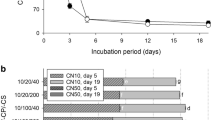Abstract
Cellulose, xylan, and glucose were compared in waterlogged soil as modifying factors of the redox potential (Eh), of the quantity of reducing equivalents, and of the soil capacity to produce N2O and CO2. During the study period (168 h) soils supplied with glucose and xylan showed a higher Eh decrease than the control soil and the soil treated with cellulose. In samples taken after 0, 24, 48, and 168 h, the soils supplied with C showed a higher number of reducing equivalents than the control soil did. These quantities were not correlated with Eh values, nor with N2O production. N2O production was increased compared with the control soil over the entire experimental period in the glucose-amended soils but only after 48 h in the xylan-amended soils and not until 168 h in the cellulose-treated soils. The CO2:N2O ratio was consistently higher than the theoretical value of 2, suggesting that denitrification and CO2 production via fermentation occurred simultaneously. Moreover, this ratio was highly correlated with the Eh values. We conclude that more research is needed to explain the role of soil redox intensity (Eh) and capacity (quantity of redox species undergoing reduction) in the expression of soil denitrification-fermentation pathways.
Similar content being viewed by others
References
Abou Seada MNI, Ottow JCG (1985) Effect of increasing oxygen concentration on total denitrification and nitrous oxide release from soil by different bacteria. Biol Fertil Soils 1: 31–38
Beauchamp EG, Trevors JT, Paul JW (1989) Carbon sources for bacterial denitrification. Adv Soil Sci 10: 113–142
Delwiche CC (1981) The nitrogen cycle and nitrous oxide. In: Delwiche CC (ed) Denitrification, nitrification, and atmospheric nitrous oxide. Wiley-Interscience, New York, pp 1–15
Ding Chang-pu, Liu Zhi-guang (1985) Reducing substances. In: Yu Tian-ren (ed) Physical chemistry of paddy soils. Science Press, Beijing, pp 27–46
Eroshin VK (1977) Material-energetic balance of micro-organism growth. Process Biochem 12: 29–31
Glinski J, Stepniewski W (1985) Soil aeration and its role for plants. CRC Press Inc, Boca Raton, Fla
Gök M, Ottow JCG (1988) Effect of cellulose and straw incorporation in soil on total denitrification and nitrogen immobilization at initially aerobic and permanent anaerobic conditions. Biol Fertil Soil 5: 317–322
Harris RF, Adams SS (1979) Determination of the carbon-bound electron composition of microbial cells and metabolites by dichromate oxidation. Appl Environ Microbiol 37: 237–243
Jackson ML (1958) Soil chemical analysis. Prentice-Hall, Englewood Cliffs, NJ
Knowles R (1982) Denitrification. Microbial Rev 46: 43–70
Lescure C, Menéndez L, Lensi R, Chalamet A, Pidello A (1992) Effect of addition of various carbon substrates on denitrification in a Vertic Mollisol. Biol Fertil Soils 13: 125–129
Lindsay WL (1979) Chemical equilibria in soils. John Wiley and Sons, New York
Liu Zhi-guang (1985) Oxidation-reduction potential. In: Yu Tian-ren (ed) Physical chemistry of paddy soils. Science Press, Beijing, pp 1–26
Lovley DR, Goodwin S (1988) Hydrogen concentration as an indicator of the predominant terminal electron-accepting reactions in aquatic sediments. Geochim Cosmochim Acta 52: 2993–3003
Oenena O, Veltorof GL (1993) Denitrification in nitric-acid-treated cattle slurry during storage. Neth J Agric Sci 41: 63–80
Ottow JCG, El-Demerdash ME (1983) Einfluß der Wasserstoffionenkonzentration (pH=4), des Sauerstoffpartialdruckes und der N2O-Spannung auf die Denitrifikationskapazität verschiedener Böden. Landwirtsch Forsch 36:270–284
Parsons LL, Scott Smith M (1989) Microbial utilization of carbon-14-glucose in aerobic vs. anaerobic denitrifying soils. Soil Sci Soc Am J 53: 1082–1085
Paul JW, Beauchamp EG (1989) Denitrification and fermentation in plant-residue-amended soil. Biol Fertil Soils 7: 303–309
Reddy KR, Rao PSC, Jessup RE (1982) The effect of carbon mineralization on denitrification kinetics in mineral and inorganic soils. Soil Sci Soc Am J 46: 62–68
Scott Smith M, Tiedje JM (1979) Phases of denitrification following oxygen depletion in soil. Soil Biol Biochem 11: 261–267
Segel I (1976) Biochemical calculations, 2nd edn. John Wiley and Sons, New York
Takai Y, Kamura T (1969) The mechanism of reduction in waterlogged paddy soil. Folia Microbiol 2: 304–313
Tiedje JM (1988) Ecology of denitrification and dissimilatory nitrate reduction to ammonium. In: Zehnder AJB (ed) Biology of anaerobic microorganisms. John Wiley and Sons, New York, pp 179–244
Watanabe I, Furusaka C (1980) Microbial ecology of flooded rice soils. Adv Microbiol Ecol 40: 125–168
Zo Bell CE (1946) Studies on the redox potential of marine sediments. Bull Am Assoc Pet Geol 30: 477–513
Author information
Authors and Affiliations
Rights and permissions
About this article
Cite this article
Pidello, A., Menéndez, L. & Perotti, E.B.R. Saccharidic compounds as soil redox effectors and their influence on potential N2O production. Biol Fertil Soils 23, 173–176 (1996). https://doi.org/10.1007/BF00336059
Received:
Issue Date:
DOI: https://doi.org/10.1007/BF00336059




